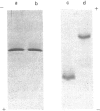Abstract
A three-disulphide derivative of hen egg-white lysozyme was made by selective reduction and carboxymethylation of one of the four original disulphide bridges. N-Terminal sequencing and two-dimensional 1H-n.m.r. spectroscopy revealed that the disulphide bridge linking cysteine residues 6 and 127 had been modified and that the three remaining disulphide bonds were native-like in nature. Analysis of COSY and NOESY spectra indicated that the three-disulphide lysozyme (CM6.127-lysozyme retains the same secondary and tertiary structure as its four-disulphide counterpart; its stability to pH and temperature is, however, dramatically decreased. N.m.r. spectroscopy was used to characterize the thermal folding and unfolding transition of CM6.127-lysozyme. Not only is the transition still a highly co-operative event, but the enthalpy change associated with folding and unfolding resembles that of intact lysozyme when their differences in thermal stability are taken into consideration. The significance of these results in terms of the folding process of lysozyme is discussed. By contrast with authentic lysozyme, CM6.127-lysozyme was found to exist in an unfolded state at pH 2 at room temperature. N.m.r. spectroscopy and c.d. were used to characterize this state. Unlike their homologous relative, alpha-lactalbumin, which exists in a partially folded molten globule state under these conditions, only residual non-native-like structure persists in the acid-unfolded state of CM6.127-lysozyme. These results indicate that the difference in folding behaviour of lysozyme and alpha-lactalbumin cannot be accounted for simply by their differences in thermal stability.
Full text
PDF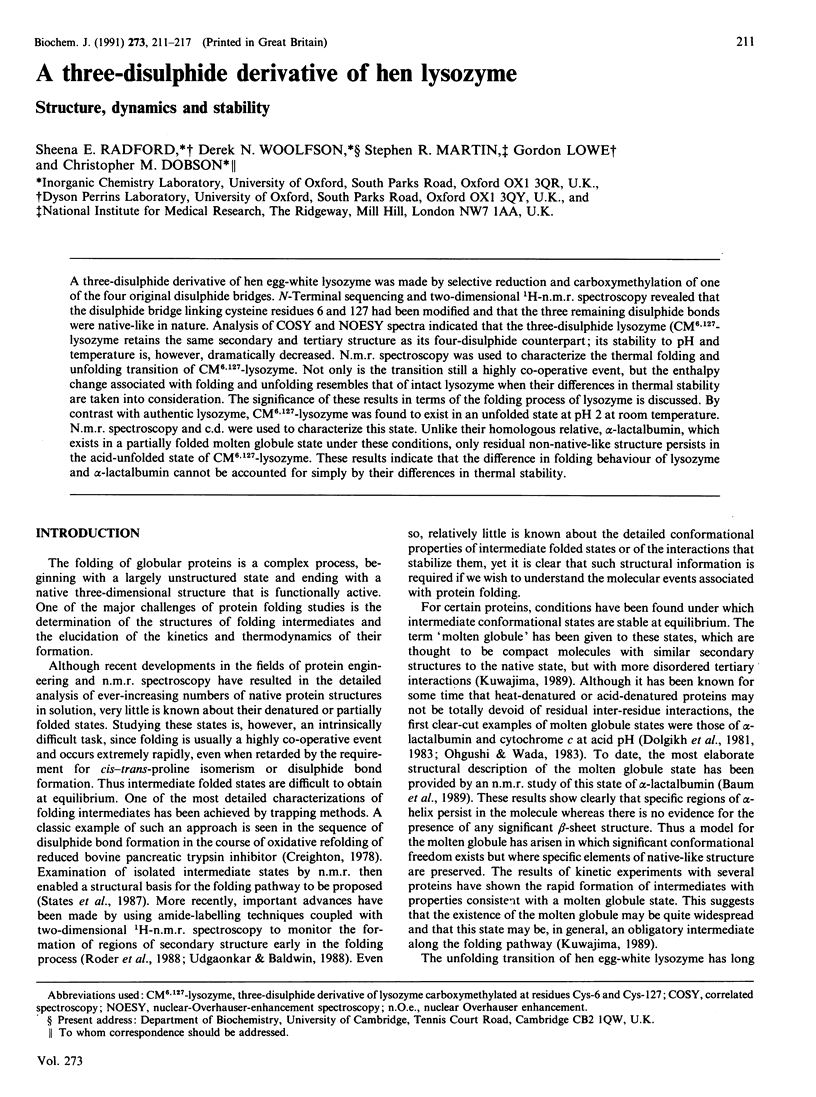

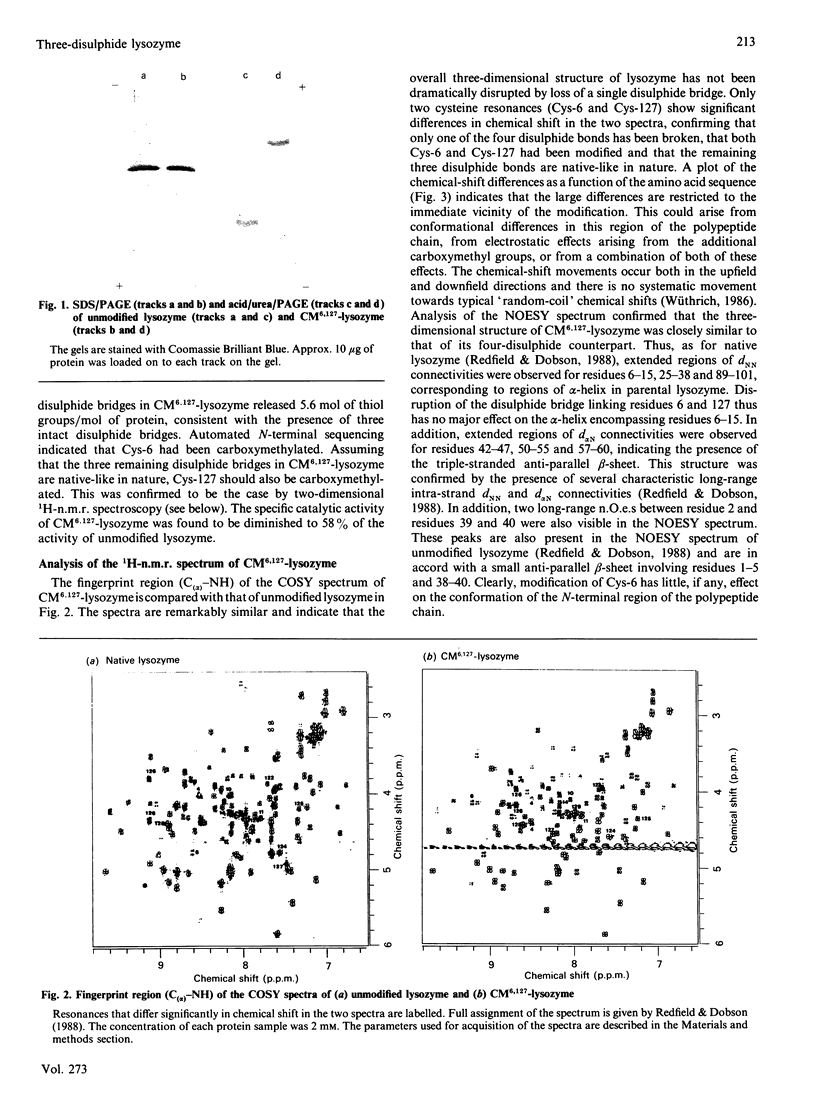

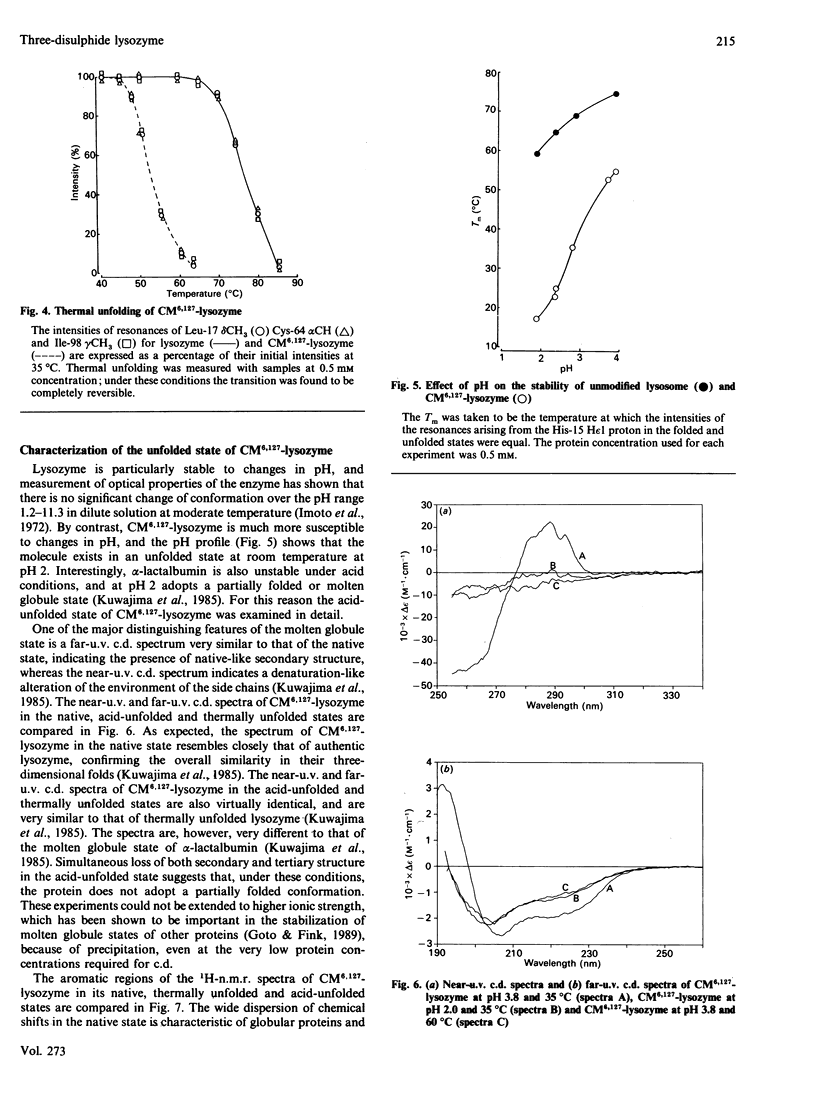
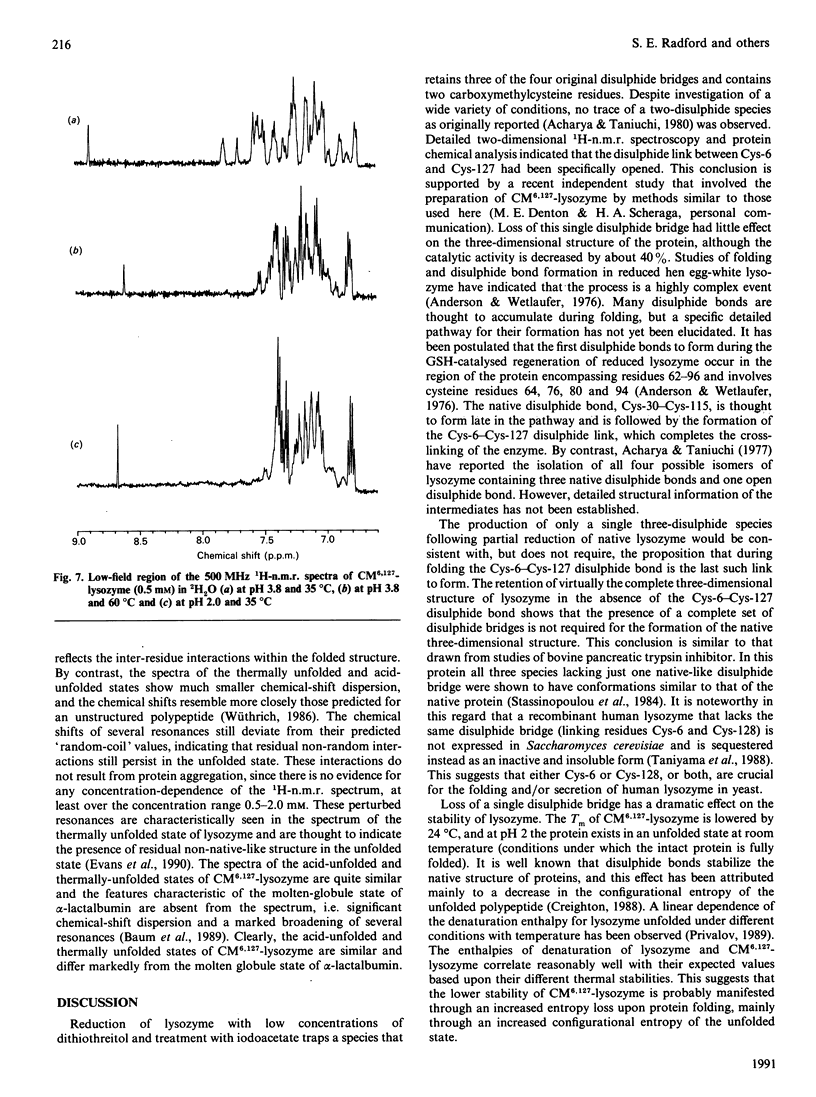
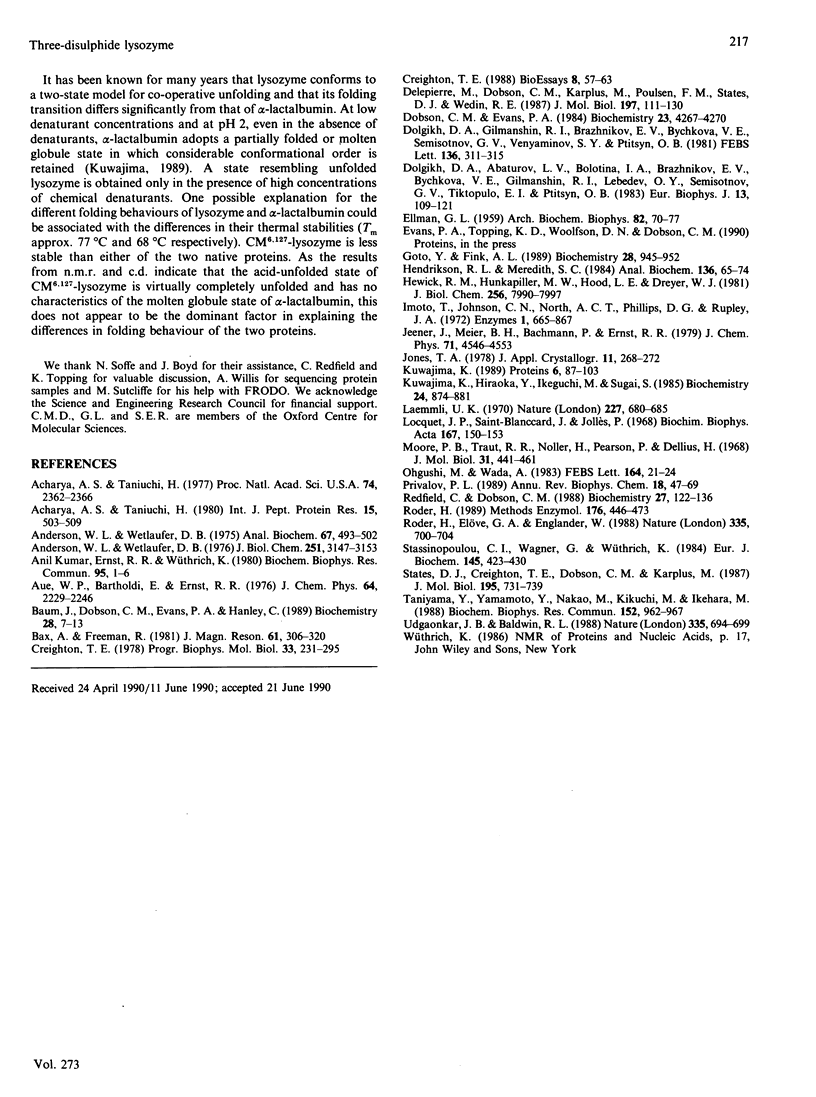
Images in this article
Selected References
These references are in PubMed. This may not be the complete list of references from this article.
- Acharya A. S., Taniuchi H. Formation of the four isomers of hen egg white lysozyme containing three negative disulfide bonds and one open disulfide bond. Proc Natl Acad Sci U S A. 1977 Jun;74(6):2362–2366. doi: 10.1073/pnas.74.6.2362. [DOI] [PMC free article] [PubMed] [Google Scholar]
- Acharya A. S., Taniuchi H. Preparation of a two-disulfide bonded enzymically active derivative from hen egg lysozyme. Int J Pept Protein Res. 1980 May;15(5):503–509. doi: 10.1111/j.1399-3011.1980.tb02928.x. [DOI] [PubMed] [Google Scholar]
- Anderson W. L., Wetlaufer D. B. A new method for disulfide analysis of peptides. Anal Biochem. 1975 Aug;67(2):493–502. doi: 10.1016/0003-2697(75)90323-1. [DOI] [PubMed] [Google Scholar]
- Anderson W. L., Wetlaufer D. B. The folding pathway of reduced lysozyme. J Biol Chem. 1976 May 25;251(10):3147–3153. [PubMed] [Google Scholar]
- Baum J., Dobson C. M., Evans P. A., Hanley C. Characterization of a partly folded protein by NMR methods: studies on the molten globule state of guinea pig alpha-lactalbumin. Biochemistry. 1989 Jan 10;28(1):7–13. doi: 10.1021/bi00427a002. [DOI] [PubMed] [Google Scholar]
- Creighton T. E. Disulphide bonds and protein stability. Bioessays. 1988 Feb-Mar;8(2):57–63. doi: 10.1002/bies.950080204. [DOI] [PubMed] [Google Scholar]
- Delepierre M., Dobson C. M., Karplus M., Poulsen F. M., States D. J., Wedin R. E. Electrostatic effects and hydrogen exchange behaviour in proteins. The pH dependence of exchange rates in lysozyme. J Mol Biol. 1987 Sep 5;197(1):111–130. doi: 10.1016/0022-2836(87)90613-9. [DOI] [PubMed] [Google Scholar]
- Dolgikh D. A., Abaturov L. V., Bolotina I. A., Brazhnikov E. V., Bychkova V. E., Gilmanshin R. I., Lebedev YuO, Semisotnov G. V., Tiktopulo E. I., Ptitsyn O. B. Compact state of a protein molecule with pronounced small-scale mobility: bovine alpha-lactalbumin. Eur Biophys J. 1985;13(2):109–121. doi: 10.1007/BF00256531. [DOI] [PubMed] [Google Scholar]
- Dolgikh D. A., Gilmanshin R. I., Brazhnikov E. V., Bychkova V. E., Semisotnov G. V., Venyaminov SYu, Ptitsyn O. B. Alpha-Lactalbumin: compact state with fluctuating tertiary structure? FEBS Lett. 1981 Dec 28;136(2):311–315. doi: 10.1016/0014-5793(81)80642-4. [DOI] [PubMed] [Google Scholar]
- ELLMAN G. L. Tissue sulfhydryl groups. Arch Biochem Biophys. 1959 May;82(1):70–77. doi: 10.1016/0003-9861(59)90090-6. [DOI] [PubMed] [Google Scholar]
- Goto Y., Fink A. L. Conformational states of beta-lactamase: molten-globule states at acidic and alkaline pH with high salt. Biochemistry. 1989 Feb 7;28(3):945–952. doi: 10.1021/bi00429a004. [DOI] [PubMed] [Google Scholar]
- Heinrikson R. L., Meredith S. C. Amino acid analysis by reverse-phase high-performance liquid chromatography: precolumn derivatization with phenylisothiocyanate. Anal Biochem. 1984 Jan;136(1):65–74. doi: 10.1016/0003-2697(84)90307-5. [DOI] [PubMed] [Google Scholar]
- Hewick R. M., Hunkapiller M. W., Hood L. E., Dreyer W. J. A gas-liquid solid phase peptide and protein sequenator. J Biol Chem. 1981 Aug 10;256(15):7990–7997. [PubMed] [Google Scholar]
- Kuwajima K., Hiraoka Y., Ikeguchi M., Sugai S. Comparison of the transient folding intermediates in lysozyme and alpha-lactalbumin. Biochemistry. 1985 Feb 12;24(4):874–881. doi: 10.1021/bi00325a010. [DOI] [PubMed] [Google Scholar]
- Kuwajima K. The molten globule state as a clue for understanding the folding and cooperativity of globular-protein structure. Proteins. 1989;6(2):87–103. doi: 10.1002/prot.340060202. [DOI] [PubMed] [Google Scholar]
- Laemmli U. K. Cleavage of structural proteins during the assembly of the head of bacteriophage T4. Nature. 1970 Aug 15;227(5259):680–685. doi: 10.1038/227680a0. [DOI] [PubMed] [Google Scholar]
- Locquet J. P., Saint-Blancard J., Jollès P. Apparent affinity constants of lysozymes from different origins forMicrococcus lysodeikticus cells. Biochim Biophys Acta. 1968 Aug 27;167(1):150–153. doi: 10.1016/0005-2744(68)90284-2. [DOI] [PubMed] [Google Scholar]
- Moore P. B., Traut R. R., Noller H., Pearson P., Delius H. Ribosomal proteins of Escherichia coli. II. Proteins from the 30 s subunit. J Mol Biol. 1968 Feb 14;31(3):441–461. doi: 10.1016/0022-2836(68)90420-8. [DOI] [PubMed] [Google Scholar]
- Ohgushi M., Wada A. 'Molten-globule state': a compact form of globular proteins with mobile side-chains. FEBS Lett. 1983 Nov 28;164(1):21–24. doi: 10.1016/0014-5793(83)80010-6. [DOI] [PubMed] [Google Scholar]
- Privalov P. L. Thermodynamic problems of protein structure. Annu Rev Biophys Biophys Chem. 1989;18:47–69. doi: 10.1146/annurev.bb.18.060189.000403. [DOI] [PubMed] [Google Scholar]
- Redfield C., Dobson C. M. Sequential 1H NMR assignments and secondary structure of hen egg white lysozyme in solution. Biochemistry. 1988 Jan 12;27(1):122–136. doi: 10.1021/bi00401a020. [DOI] [PubMed] [Google Scholar]
- Roder H., Elöve G. A., Englander S. W. Structural characterization of folding intermediates in cytochrome c by H-exchange labelling and proton NMR. Nature. 1988 Oct 20;335(6192):700–704. doi: 10.1038/335700a0. [DOI] [PMC free article] [PubMed] [Google Scholar]
- Roder H. Structural characterization of protein folding intermediates by proton magnetic resonance and hydrogen exchange. Methods Enzymol. 1989;176:446–473. doi: 10.1016/0076-6879(89)76024-9. [DOI] [PubMed] [Google Scholar]
- Stassinopoulou C. I., Wagner G., Wüthrich K. Two-dimensional 1H NMR of two chemically modified analogs of the basic pancreatic trypsin inhibitor. Sequence-specific resonance assignments and sequence location of conformation changes relative to the native protein. Eur J Biochem. 1984 Dec 3;145(2):423–430. doi: 10.1111/j.1432-1033.1984.tb08571.x. [DOI] [PubMed] [Google Scholar]
- States D. J., Creighton T. E., Dobson C. M., Karplus M. Conformations of intermediates in the folding of the pancreatic trypsin inhibitor. J Mol Biol. 1987 Jun 5;195(3):731–739. doi: 10.1016/0022-2836(87)90192-6. [DOI] [PubMed] [Google Scholar]
- Taniyama Y., Yamamoto Y., Nakao M., Kikuchi M., Ikehara M. Role of disulfide bonds in folding and secretion of human lysozyme in Saccharomyces cerevisiae. Biochem Biophys Res Commun. 1988 May 16;152(3):962–967. doi: 10.1016/s0006-291x(88)80377-2. [DOI] [PubMed] [Google Scholar]
- Udgaonkar J. B., Baldwin R. L. NMR evidence for an early framework intermediate on the folding pathway of ribonuclease A. Nature. 1988 Oct 20;335(6192):694–699. doi: 10.1038/335694a0. [DOI] [PubMed] [Google Scholar]



